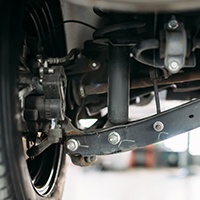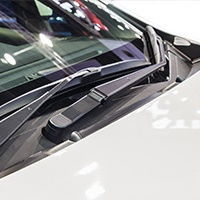Shock absorbers limit the amount of suspension movement by dampening spring oscillations.
Struts reinforce the active components of the suspension to the same end.
Shocks and Struts keep you from hitting your head on the ceiling of the vehicle every time you hit a bump and from vibrating while traveling on rough roads.
Here is a great video that explains how your suspension works.
How can you tell when you need to replace shocks and struts on your vehicle?
Here are several signs that your vehicle may need shock and strut replacements.
Noticing these signs as soon as they happen can prevent damage to your vehicle. Here are some of the signs you should be looking for.
A Bumpy Ride
The main goal of shocks and struts is to prevent the amount of suspension movement. The most common sign that you need to have them inspected is if you have a bumpy ride.
Your car is designed to comfortably withstand a certain amount of movement, so if you experience bumpiness or shakiness while driving, your shocks and struts are most likely worn out.
Poor Steering
One of the first signs you may notice is poor steering response. Your steering wheel will often become stiff and hard to turn. There also may be unusual noises when turning the wheel.
In addition, you may find that your car sways or leans on turns or when changing from one lane to the other.
Braking Issues
When your struts are worn or damaged, you may notice a “nose-diving” sensation as well as instability while braking.
If you feel a lurch forward while braking, you’ll need to have your struts and shocks inspected.
Visually Damaged Struts
Strut damage is often better felt than seen, you might notice dented or damaged struts or shocks.
In addition to this physical damage, fluid leaks among struts and shocks are a sign they are worn out. Your mounts and bushings can also become corroded, damaged, or worn as time goes on.
Unusual Tire Wearing
If your tires show unusual wear patterns it may be caused by your worn out shocks and struts.
Suspension damage can cause cupping in tires, which is when cups or scalloped dips develop around the edge of your tread.
Cupped tires can be incredibly dangerous, so it’s important to look into having your tires rotated or replaced at the same time you replace your shocks.
Mileage and Time
Depending on vehicle and driving conditions, many cars require shock and strut replacements sometime after the 80,000 km marker. Instead of waiting for noticeable problems, you might consider having your suspension checked once you reach the 80,000 km.
Maintaining shocks and struts can prevent long-term damage to your car. Because everything in the car is connected, a problem with the suspension can lead to other problems.
Suspension problems can also be particularly rough on tires, which can become dangerous and expensive to replace.




